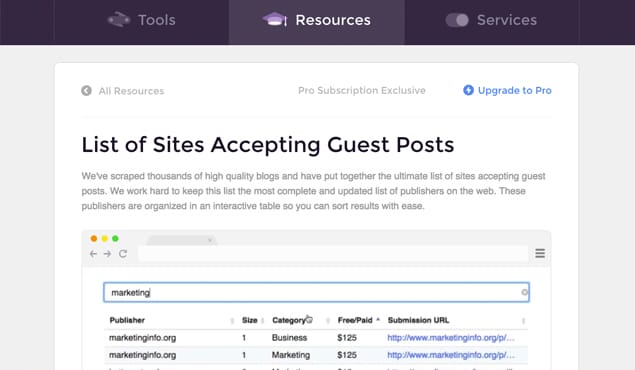Guest blogging is a great way to get links, traffic, brand recognition, name recognition, and more. By publishing your content on other sites, particularly high profile sites, you open up opportunities you wouldn’t otherwise be able to access. Your own site might not be that high up in terms of traffic or reputation, but guest posting for a site a step or two above your own allows you to leverage that presence into successively higher steps up. Eventually you’ll be contributing to sites like Moz, Forbes, and other giants in whatever industry you’re a part of.
Guest blogging is at once very simple and quite difficult. There’s more to it than just writing a blog post and hoping someone picks it up, but if you’re already capable of writing a good blog post, a lot of the hard work is already done. Let’s look at the process.
Step 1: Identify Target Blogs
The first thing you need to do is identify the blogs you would like to write for on a guest posting basis. There are a few things to keep in mind here.
First of all, there’s a difference between a guest contributor and a regular contributor. A guest poster likely will not get an account or a profile on the site, though they might, depending on the infrastructure the site uses. They also won’t typically be paid for their contribution; the byline is considered enough. On the other hand, guest contributors aren’t expected to maintain a constant flow of posts, work directly with editors, or otherwise be regular writers for the site. You don’t necessarily need to learn every detail of the site’s style guide, though you will need to learn the basics so your writing can fit in with what they normally publish.
As someone looking to guest post, you don’t want to get caught up in a job application process. If they start talking about salaries or weekly contributions, you have to carefully decide if you actually want to become a writer for this site, or if all you want is a guest post. For the sake of this post, we’re going to assume all you want is the occasional guest contribution.
The second thing you need to keep in mind is that sites will be divided into three broad categories.
- Low tier sites: These are the sites that aren’t likely to get you a lot of value. That’s not to say that they’re bad sites, just that they aren’t valuable to you in your marketing. A guest post on one such site might be useful to leverage into a site one tier up, but generally it won’t bring you much traffic and it won’t give you a lot of link juice.
- Mid tier sites: These are the sites that are more valuable to you, but aren’t kings of the industry. They are reasonably attainable guest posting spots. You don’t necessarily need a ton of experience or a huge portfolio and list of references to get in, but you will need to have more to your name than a small microsite and half-baked blog. These sites are also more likely to drive traffic and be valuable links, though again, they aren’t the best resources around.
- Top tier sites: These sites are the dream. They’re the best places for you to get guest posts published. Places like Forbes, the Huffington Post, and other big name sites bring in a ton of value. They have the potential to bring in thousands of readers a day, and their links are going to be incredibly potent. The kicker is, they’re difficult to get into, hard to contact, and generally require a lot of references.
The general process is going to be starting with a handful of low tier sites to leverage into getting into the mid-tier sites, which will then help you get into the high tier sites.
So, your first step is to scour your industry looking for sites. Every site you find should be categorized into one of those three columns. A few sites will slip through as well, and will be completely unsuitable. These are sites that are either those of your competitors, who won’t want to publish your content or benefit you, or spam sites that you wouldn’t want your name attached to at all.
Build this list in a spreadsheet, and keep track of information for each site. Keep track of any posts you’ve published and the dates they were accepted, as well as the contact information and any other special notes you need, like word count and editorial guidelines.
Step 2: Create a Portfolio
Now, what most people do at this point is go out to those sites and start pitching guest post ideas. I say they’re skipping one important aspect of the process that can dramatically improve your chances of success. Preparation.
Here’s what I recommend doing. Study the content library, particularly the most recent six months of what the site has published on their blog. Pay special attention to any other guest posts published by the site, if any. This will give you an idea of the length, the content, the style, and the voice of the blog.
Once you have this idea in mind, write 2-3 pieces of content in the same style, but with your own blog requirements layered over top. You don’t want to compromise your voice or tone, but you do want to produce something that looks attractive to the site in question. Essentially, you’re creating something that wouldn’t look out of place on the site you’re trying to get published on.
At least one of these pieces will be directly linked in the application you send for guest posting. Possibly all of them will be, depending on how you format your contact. I generally like a line such as “here are a couple of examples of the content I produce for my own site.” It’s a seed for the site owner to see “your” style, by which I mean the style you mimic from them. They’ll be pleased at how well you fit their guidelines without even being told, or even submitting that content to them, and will be more likely to accept.
As an added bonus, this is good content on your site that can attract visitors, links, and search engine value on its own. You lose nothing by producing this content except a little bit of time, and you improve the chances of your guest posts being accepted.
Step 3: Reach Out to Blog Owners or Editors
Once you have your portfolio put together, it’s time to find the contact information and reach out to the owners of the blogs you’re trying to reach. Some of them will be small enough to have single blog owners you want to contact. Others might have managing editors doing the job for them. For example, if you want to get published on the Huffington Post, you probably aren’t going to be able to reach out directly to Arianna Huffington herself. Instead, you’ll likely want to contact a managing editor or communications director listed in their editorial staff for the section of the site you want to appear on.
Some sites will make it easy. Look for a contact page or a “write for us” page. If there isn’t one in clear view, you can do a Google site search – site:www.example.com – for “write for us” or “contribute” or another common keyword.
In general, you want to follow the guidelines set forth by the site first and foremost. If you want to write for the Huffington Post, you should send them a blog pitch through the contact information here. Don’t resort to direct contacts with editors unless your official contact has been ignored or denied. Many site editors are busy enough that they won’t look favorably upon someone who fills their inbox when a different method of contact is preferred.
I prefer to limit my use of the “big guns,” that is, the email information for site owners and CEOs, to only when other methods of contact have failed. It’s a last resort, not a default start.
Step 4: Pitch Guest Post Ideas
When you get a successful contact, it’s time to pitch an idea. Again, this will vary depending on the site you want to contact. Some of them will prefer you just send in the full text of the article you want to publish, and they will make a judgment. In these cases, write something excellent for their site – see the next step for more on that – and submit it. You’ll get one of four responses. Either you will be accepted and published, you will be ignored, you will be denied with no recourse, or you will be rejected with some suggestions you can use to improve and resubmit. React accordingly and don’t give up just because you’re rejected. Rejection is an opportunity to improve, or to find a new contact within the organization if it’s a sufficiently large site.
Other sites will prefer that you send in a pitch for a post before you spend time writing it. You never know if they have something in the pipeline for a given topic, and they may not want to duplicate coverage if they can help it. It saves you time and energy to make a pitch first.
Step 5: Write Excellent Posts
Once you’re to the point in the process where you need to write a post, you need to, well, write the post. The first thing you want to do here is look up the editorial guidelines for the site in question. This will help you determine the level of formality, the tone of voice, the perspective, and the rules they have for grammar on their site. For example, some sites are sticklers for AP style and will reject you for the use of the oxford comma or for not capitalizing the word Internet. Others are much more informal. Some prefer a “we” perspective, others want an “I” perspective, and still others don’t want any self-reference at all. If you can’t find editorial guidelines, you can glean much of this information from reading their posts.
Again, submitting your content could get it rejected, returned with revision requests, or accepted. React accordingly. Be tenacious in the fact of rejection; the fact that they’ve read it at all and give you the time of day is a good sign. You just have to find what they’re looking for.
Step 6: Promote Guest Posts When Published
Once published, a guest post is going to go through the promotion engine of the site that published it. It will likely be shared on social media, published in their RSS feed, and will attract blog comments. This all benefits you in terms of name awareness and link clicks, if they allowed you a link to your site.
If you want to publish on this site again, here’s a trick; run the post through your own promotion. Share it on your social media, link to it prominently on your site, and share it with any influencers you know. This will benefit the site you’re publishing on, which will benefit you. Ideally, it will make your guest post shine in their analytics and will make them welcome you coming back to write again.
Now, some sites don’t allow links in their guest posts, or will strip out any links you add in to your own sites. This is a reaction to guest post SEO fears from a few years back, and while it’s completely reasonable, some people feel like a guest post is valueless without these links. I have another trick for you; comment on your blog post. When someone else comments on it, respond as if it was a comment on your site. You can often include a link to your website in your Disqus profile or whatever profile information they use for their comment system, so you can sneak a link in this way. It’s not a valuable link in terms of SEO, but it’s going to get some organic clicks.
Step 7: Leverage Posts Into Better Positions
Rinse and repeat. Once you’ve been published once, it’s easier to be published again. The more your name has been spread about on sites in your industry, the more you’ll be able to get into higher tier sites. You can work your way up the list, and eventually gain the notice of the industry giants.
 ContentPowered.com
ContentPowered.com








